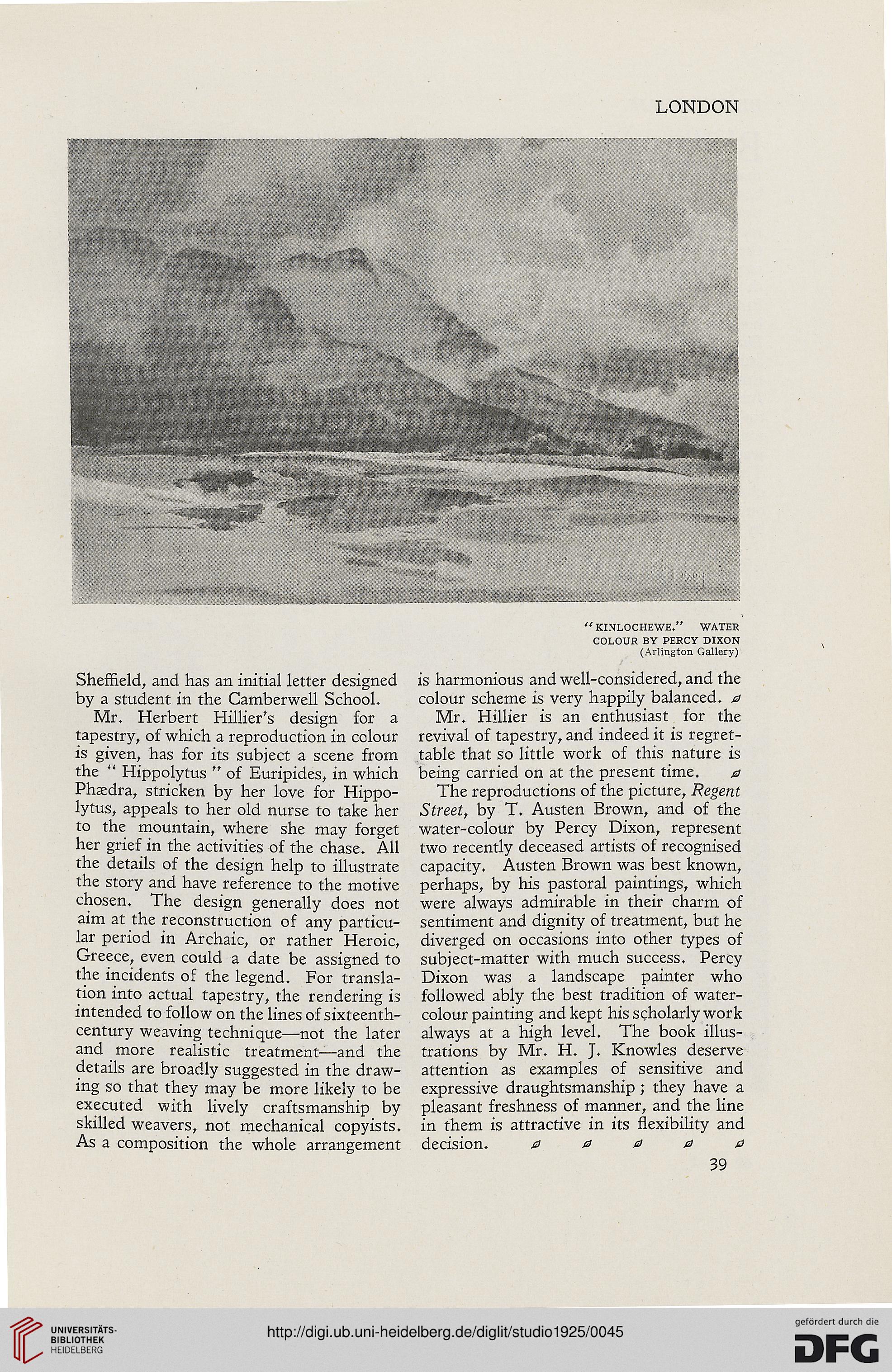LONDON
"KINLOCHEWE." WATER
COLOUR BY PERCY DIXON
(Arlington Gallery)
is harmonious and well-considered, and the
colour scheme is very happily balanced. 0
Mr. Hillier is an enthusiast for the
revival of tapestry, and indeed it is regret-
table that so little work of this nature is
being carried on at the present time. 0
The reproductions of the picture, Regent
Street, by T. Austen Brown, and of the
water-colour by Percy Dixon, represent
two recently deceased artists of recognised
capacity. Austen Brown was best known,
perhaps, by his pastoral paintings, which
were always admirable in their charm of
sentiment and dignity of treatment, but he
diverged on occasions into other types of
subject-matter with much success. Percy
Dixon was a landscape painter who
followed ably the best tradition of water-
colour painting and kept his scholarly work
always at a high level. The book illus-
trations by Mr. H. J. Knowles deserve
attention as examples of sensitive and
expressive draughtsmanship ; they have a
pleasant freshness of manner, and the line
in them is attractive in its flexibility and
decision. 00000
39
Sheffield, and has an initial letter designed
by a student in the Camberwell School.
Mr. Herbert Hillier's design for a
tapestry, of which a reproduction in colour
is given, has for its subject a scene from
the " Hippolytus " of Euripides, in which
Phaedra, stricken by her love for Hippo-
lytus, appeals to her old nurse to take her
to the mountain, where she may forget
her grief in the activities of the chase. All
the details of the design help to illustrate
the story and have reference to the motive
chosen. The design generally does not
aim at the reconstruction of any particu-
lar period in Archaic, or rather Heroic,
Greece, even could a date be assigned to
the incidents of the legend. For transla-
tion into actual tapestry, the rendering is
intended to follow on the lines of sixteenth-
century weaving technique—not the later
and more realistic treatment—and the
details are broadly suggested in the draw-
ing so that they may be more likely to be
executed with lively craftsmanship by
skilled weavers, not mechanical copyists.
As a composition the whole arrangement
"KINLOCHEWE." WATER
COLOUR BY PERCY DIXON
(Arlington Gallery)
is harmonious and well-considered, and the
colour scheme is very happily balanced. 0
Mr. Hillier is an enthusiast for the
revival of tapestry, and indeed it is regret-
table that so little work of this nature is
being carried on at the present time. 0
The reproductions of the picture, Regent
Street, by T. Austen Brown, and of the
water-colour by Percy Dixon, represent
two recently deceased artists of recognised
capacity. Austen Brown was best known,
perhaps, by his pastoral paintings, which
were always admirable in their charm of
sentiment and dignity of treatment, but he
diverged on occasions into other types of
subject-matter with much success. Percy
Dixon was a landscape painter who
followed ably the best tradition of water-
colour painting and kept his scholarly work
always at a high level. The book illus-
trations by Mr. H. J. Knowles deserve
attention as examples of sensitive and
expressive draughtsmanship ; they have a
pleasant freshness of manner, and the line
in them is attractive in its flexibility and
decision. 00000
39
Sheffield, and has an initial letter designed
by a student in the Camberwell School.
Mr. Herbert Hillier's design for a
tapestry, of which a reproduction in colour
is given, has for its subject a scene from
the " Hippolytus " of Euripides, in which
Phaedra, stricken by her love for Hippo-
lytus, appeals to her old nurse to take her
to the mountain, where she may forget
her grief in the activities of the chase. All
the details of the design help to illustrate
the story and have reference to the motive
chosen. The design generally does not
aim at the reconstruction of any particu-
lar period in Archaic, or rather Heroic,
Greece, even could a date be assigned to
the incidents of the legend. For transla-
tion into actual tapestry, the rendering is
intended to follow on the lines of sixteenth-
century weaving technique—not the later
and more realistic treatment—and the
details are broadly suggested in the draw-
ing so that they may be more likely to be
executed with lively craftsmanship by
skilled weavers, not mechanical copyists.
As a composition the whole arrangement




